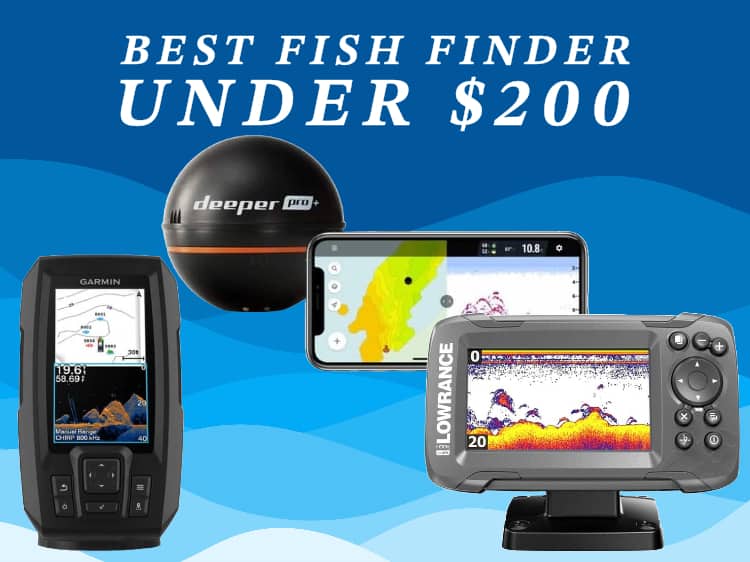Cheap fish finders can be surprisingly effective, especially for hobbyists, beginners, or those who don’t need advanced features. Many budget-friendly models offer basic sonar readings, which can be sufficient for detecting fish, identifying underwater structures, and understanding bottom contours. They might lack the bells and whistles of pricier models, but they serve their primary purpose: helping anglers locate fish.
For a budget under $200, you can find fish finders that offer traditional 2D sonar, and some even come with basic GPS or Down Imaging functionalities. The key is to manage expectations: while they won’t provide the crystal-clear images or extensive mapping features of higher-end models, they can still be very useful for detecting fish and underwater structures.
Here are the best fish finders under $200 price range:
- Deeper Pro+
- Garmin Striker Vivid 4CV
- Lowrance Hook2 4x
- Humminbird HELIX 5 SONAR G2
- IBobber ReelSonar Wireless Bluetooth Smartphone Fish Finder
Best fish finders under $200 – Review
1. Deeper Pro+
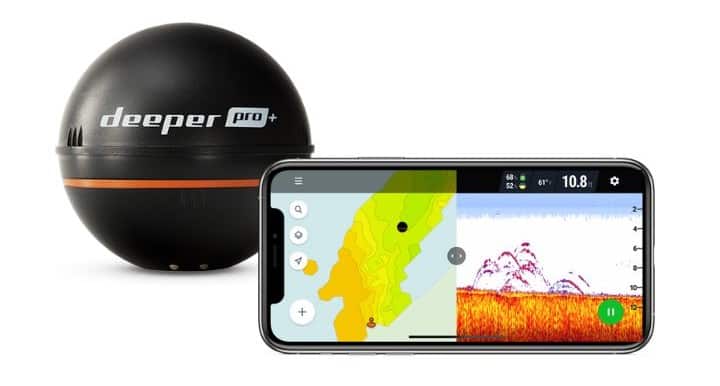
The Deeper Pro+ is a castable, wireless fish finder that’s designed for versatility and portability. Unlike traditional boat-mounted units, it can be used from the shore, a kayak, or even while ice fishing. You cast it into the water, and it sends sonar data back to your smartphone or tablet via Wi-Fi.
One of its standout features is the built-in GPS, which allows you to create bathymetric maps of your fishing spots. This means you can map the underwater topography of lakes or rivers, a feature usually found only in more expensive, boat-mounted units.
The Deeper Pro+ scans down to a depth of 260 feet with a dual-beam sonar, providing you with detailed information on fish locations, structure, and even water temperature.
It’s priced just under $200 and is an ideal option for anglers who fish in various environments and need a portable, flexible solution.
Pros:
- Portable
- WiFi Connectivity
- Integrated GPS
- Dual-beam Frequency 90/290 kHz
- Long casting range of 330 feet (100 m)
- Water temperature and water depth measuring capability
Cons:
- Not suitable for deep waters
- No high-resolution imaging
- Dependency on Smartphone/Tablet
2. Garmin Striker Vivid 4CV
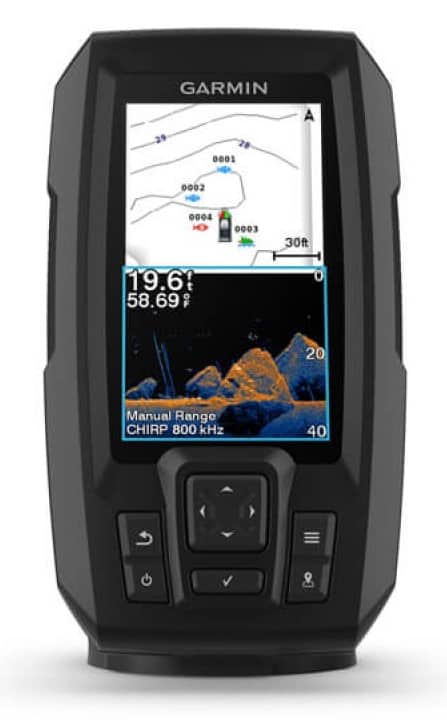
Garmin’s Striker Vivid 4CV is a more affordable boat-mounted fish finder, priced between $150 to $200.
It comes with a bright 4-inch color display screen that is easy to read under direct sunlight. The keypad is intuitive and makes it easy to navigate to different features.
It features CHIRP sonar, which offers clearer fish arches and better target separation compared to traditional sonar.
One of its notable features is ClearVü (Down Imaging) scanning, which provides a nearly photographic image of what’s below the boat. This is extremely helpful in identifying underwater structures where fish might be hiding.
It also comes with a built-in GPS, allowing you to mark waypoints, create routes, and even check your boat speed.
The Striker Vivid 4CV is particularly useful for anglers who have a small boat and want a reliable, feature-packed fish finder without breaking the bank.
Pros:
- Easy to use
- Variety of sonar frequency ranges 50/75/200/455/800 kHz
- Able to scan to max depth of 1900 ft.
- CHIRP Sonar and Down Imaging (ClearVu)
- Built-in GPS
- Able to measure water temperature, depth, and boat speed
Cons:
- Small Screen
3. Lowrance Hook2 4x
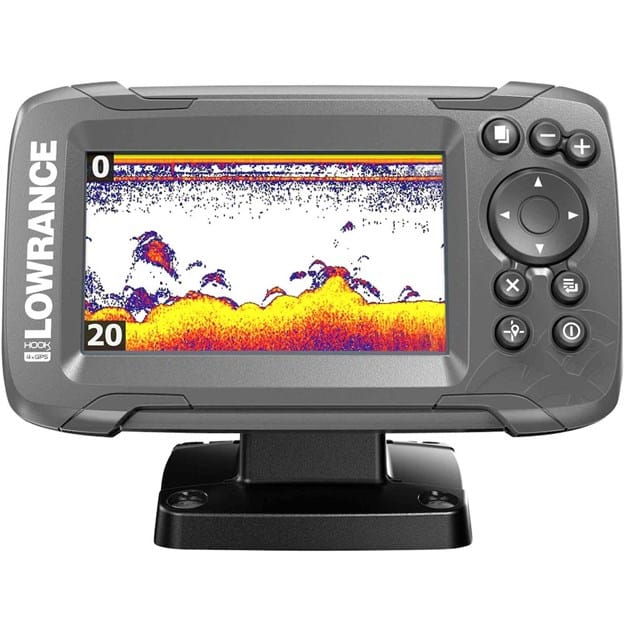
Lowrance’s Hook2 4x is priced at around $120, making it a budget-friendly option. It comes with a 4-inch screen and features auto-tuning sonar, which essentially automates the settings for you, making it easier to use for beginners.
The unit operates on a single frequency of 200 kHz with a wide angle transom mount transducer. This would be best for shallow to medium-depth fishing because higher frequencies give better detail in shallower waters but lack the penetration needed for deep water.
The Hook2 4x also offers basic navigation with a GPS plotter, which is a nice touch for anglers who want to mark fishing spots or follow trails.
This model is best suited for small boats, kayaks, or even as a backup on larger boats. It’s simple and doesn’t offer advanced features like Down Imaging, but it’s great for those who need basic sonar and GPS functionalities without spending a lot.
Pros:
- Cheap
- User-friendly with auto-tuning sonar
- Basic GPS plotter for simple navigation
- Intuitive keypad
- Suitable for small boats and kayaks
Cons:
- Single frequency (200 kHz), less versatile
- Lacks advanced features like Down Imaging
4. Humminbird Helix 5 Sonar G2
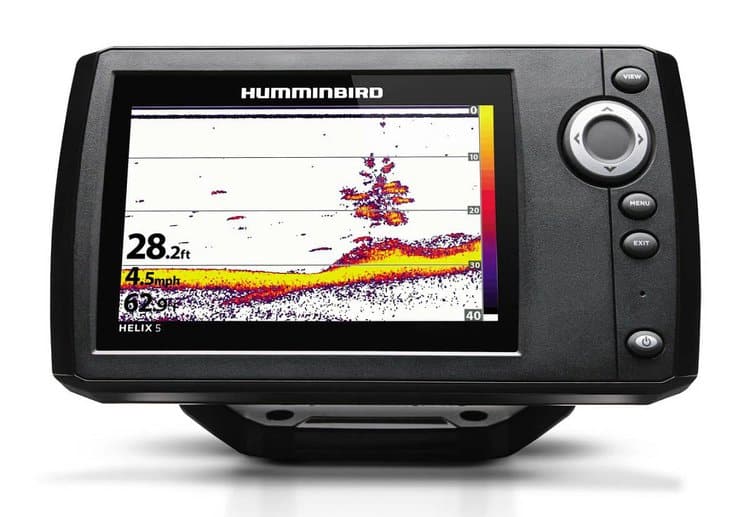
The Helix 5 SONAR G2, priced at $180, comes with a 5-inch widescreen display, offering more screen real estate compared to other fish finders in $200 price range.
It features Dual Beam PLUS Sonar, which provides two ways to search: a narrow beam for high accuracy and a wide beam when you want a larger search area. It supports sonar frequencies of 83/200 kHz and can scan up to a depth of 1,500 feet with the standard transducer. This makes it versatile for both shallow and deep-water fishing.
However, it lacks GPS, which means you won’t be able to mark fishing spots or navigate routes. This could be a significant drawback for those who rely on GPS for their fishing trips. Given its depth range and dual-beam capabilities, it’s well-suited for medium to large-sized boats where deep water fishing is more common.
Pros:
- 5-inch widescreen display for better visibility
- Dual Beam PLUS Sonar for versatile scanning
- Deep scanning capability up to 1,500 feet
- Good for shallow and deep water fishing
Cons:
- No GPS
- No imaging capabilities
5. iBobber ReelSonar Wireless Bluetooth Smartphone Fish Finder
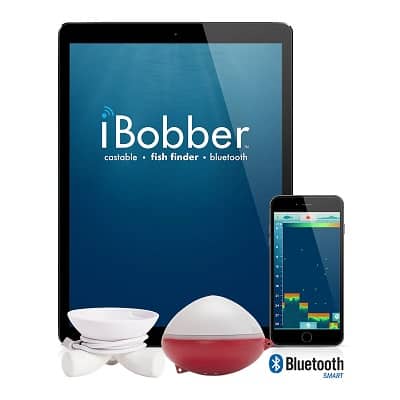
iBobber is a castable sonar bobber that you attach to your fishing line and cast into the water. It sends sonar data directly to an app on your smartphone, which then displays fish locations, depth, water temperature, and other relevant information.
Price-wise, it’s the best cheap option, costing less than $100. The affordability and simplicity make it a popular choice for casual anglers and beginners. Since it pairs with your smartphone, there’s no need to install or mount a separate unit on your boat, which is great for kayaks, canoes, or even shore fishing.
However, it’s worth noting that its capabilities are somewhat limited compared to more traditional fish finders.
The iBobber operates on a single frequency and doesn’t offer advanced features like CHIRP, Down Imaging, or Side Imaging. Its depth range is also less than more expensive models, generally effective up to about 135 feet. While it does offer basic fish and structure detection, its capabilities are limited in providing detailed underwater information.
One of the unique features is its social media integration, allowing you to easily share your catch and data with friends. It also offers basic GPS functionalities for marking hotspots, but these are dependent on your phone’s GPS capabilities.
In summary, the iBobber ReelSonar is a cheap and portable option best suited for casual fishing outings. Its limitations in sonar capabilities and depth range make it less suited for serious or professional anglers, but for under $100, it offers a unique and convenient way to get basic fish locations and depth readings.
Pros:
- Affordable, under $100
- Extremely portable and lightweight
- Easy to use with smartphone app
- No installation required; great for kayaks and small boats
- Basic GPS functionalities for marking spots
- Social media integration for easy sharing
Cons:
- Limited sonar capabilities
- Lacks advanced features like CHIRP, Down Imaging, Side Imaging
- Dependent on smartphone for display and GPS
- Limited depth range, up to 135 feet
- Single frequency operation
- Limited utility for serious or professional anglers
How to choose a cheap fish finder under $200
When looking for a fish finder under $200, pay attention to the following key features:
- Sonar Type
- Transducer frequency
- Screen Size and Resolution
- GPS Functionality
- Portability
We will discuss the above key features in detail to help you find the best fish sonar in the $200 budget.
Sonar Type
In the $200 budget range, the types of sonar available are:
- Traditional 2D Sonar: This is the most basic type of sonar and is available in all fish finders. It provides a 2D view of what’s directly beneath your boat. Fish are shown as arches, and the depth, structure, and bottom hardness can be determined based on the echoes returned.
- CHIRP Sonar: CHIRP stands for Compressed High-Intensity Radiated Pulse. Instead of sending a single frequency, CHIRP sonars send a range of frequencies, from low to high, and interpret the combined returns. This results in better target separation, crisp fish arches, clearer images, and fewer noise artifacts.
- Down Imaging (DownScan or ClearVu): This is a more advanced form of traditional sonar that provides a more detailed and photographic-like view of the water column and structures beneath your boat. It’s excellent for identifying fish from structures.
You should aim for a fish finder that offers Down Imaging and CHIRP sonar if it’s available within your budget.
Transducer Frequency
The transducer frequency you should choose depends on the type of fishing you’ll be doing and the conditions in which you’ll be fishing. Here’s a general guide:
- High Frequency (Around 200 kHz or Higher): Best for shallow water fishing. High frequencies provide the finest detail but are less effective in deep water. They are ideal for detecting small fish and getting a detailed view of the underwater structure in freshwater lakes, rivers, and shallow coastal areas.
- Low Frequency (Around 50 kHz): Suitable for deep water fishing. Low frequencies penetrate deeper into the water but provide less detail. These are ideal for saltwater fishing, deep lake fishing, and commercial fishing.
- Mid-range Frequencies (Around 83 kHz): These provide a good balance between detail and depth, making them versatile for both shallow and deep water but excel in neither.
- CHIRP: If your fish finder supports CHIRP, this is usually the best option as it uses a range of frequencies for more detailed and accurate images. It’s effective in both shallow and deep water.
- Dual or Multiple Frequencies: Some fish finders allow you to switch between frequencies or even use multiple frequencies at the same time. This provides a more versatile fishing experience, allowing you to adapt to different conditions.
Choose the frequency based on where you’ll be fishing most often and what you need from your fish finder. If you’re a versatile angler who fishes in a variety of conditions, consider a fish finder that offers multiple frequencies or CHIRP technology.
Screen Size and Resolution
The screen size and resolution of a fish finder play a significant role in how easily you can interpret the data it provides. Larger screens and higher resolutions offer better visibility and detail.
In the $200 price range, you’re likely to find smaller screens ranging from 3.5 to 5 inches. The resolution at this price point is often around 480×272 or 800×480 pixels.
For quality fishing and boating, it would be best to aim for the largest screen and highest resolution available within your budget.
GPS Functionality
GPS functionality in a fish finder allows you to mark waypoints, create routes, and sometimes even view basic maps. This is particularly useful for marking fishing hot spots, navigating back to specific locations, and tracking your boat’s speed and direction.
In the $200 range, most fish finders offer basic GPS plotting capabilities. You can usually mark waypoints, and some models may offer basic trail plotting. It’s rare to find detailed cartographic features or advanced mapping options at this price point.
For a quality fishing and boating experience, a basic GPS fish finder should suffice. Being able to mark waypoints is often enough for recreational anglers. However, a unit that offers more advanced GPS features like basic chart plotting or even rudimentary map overlays, is worth considering.

Portability
Portable fish finders are often compact, lightweight, and come with a carrying case or handle. Many portable fish finders are also castable, meaning you can cast them into the water from the shore, or even boat.
Choosing a portable fish finder is ideal in several scenarios:
- Multiple Vessels: If you fish from different platforms—like a kayak, a rented boat, and a friend’s boat—a portable fish finder is a flexible solution that can move with you.
- Kayak and Canoe Fishing: Space is at a premium on small boats, and a portable unit often takes up less space and can be easily removed when not needed.
- Shore Fishing: Castable fish finders can be thrown into the water from the shore, giving you valuable data where a boat-mounted unit couldn’t go.
- Ice Fishing: Portable units are perfect for ice fishing as they can be easily moved from hole to hole.
- Budget: Portable fish finders are generally less expensive than larger, more complex units, making them a good option for beginners or those on a budget.
- Ease of Use: Portable units are often simpler and more intuitive, ideal for those who are new to using fish finders.
In summary, a portable fish finder is a versatile and practical option for anglers who value flexibility, simplicity, and convenience.
Is a cheap fish finder good for small boats
Yes, a cheap fish finder can be a good option for small boats, especially for those who are new to fishing or have basic needs. Affordable fish finders often come with essential features like basic sonar, GPS plotting, and small but readable screens. Their compact size is generally well-suited for the limited space available on a small boat.
However, it’s essential to understand that lower-cost units may lack advanced features like Side Imaging. The frequency options and depth range may also be limited. But for basic fishing needs, such as identifying fish arches and underwater structures in shallow to medium depths, a cheap fish finder can be quite effective.
If you’re fishing in a small boat like a kayak or a dinghy, you may also appreciate the portability that many cheap fish finders offer. Some can even be cast from the boat and send data back to a smartphone, eliminating the need for a fixed installation.
So, while you may miss out on some advanced features, a cheap fish finder can still provide valuable assistance in locating fish, marking spots, and navigating, making it a good option for small boats.

